|
Most online learning platforms have a good enrollment rate, but the completion rate for courses is poor. Through a qualitative study (interviews, surveys, participatory design activitity) we tried to get a broader understanding on how gamification could be used as a motivation for learning, including the social context of participants. Further, we developed a gamified mobile application for practicing python and ran a longitudinal study (over 4 weeks of remote use, with intermediate surveys, and followed by interviews) to get an in-depth understanding of game elements that motivate learning.  |
The focus of the project is on designing an in-car gaming experience for passengers. While in-vehicle entertainment is a growing field, we see the opportunity to design in-vehicle entertainment through digital games. |
The Garden of Us is an interactive digital garden that promotes connection and community well-being found on the Media Bridge, a mixture of vertical and horizontal screens helping to connect Georgia Tech's Libraries. Created by a multidisciplinary team, guests contribute to the digital garden by painting and submitting a personalized flower using a mobile web application. Watch as the garden grows, shifts, and evolves as more unique flowers are added. Every addition is welcome as it reflects Georgia Tech's diverse community. |
Georgia Tech and the Human Interface Branch of NASA partnered together to find a way to detect astronauts' body positions in space. In the zero-gravity space environment, it becomes difficult to monitor tasks that lead to repetitive stress injuries or fatigue. Monitoring movement would help NASA pinpoint high-stress actions and make adjustments to corresponding mission tasks. We developed an unobtrusive, textile-based system to monitor astronauts' arm position in real time, in zero gravity, and without the constraints of camera-based motion-input devices. 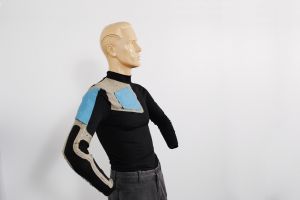 |
|
Gaming for good  Website: |
A framework to use machine learning techniques to generate rhythm action game stages from music |
A textual visualization that analyzes and presents beer review data to allow users to find a beer that meets their tastes. |
The Partnership for Inclusive Innovation supports community research across the State of Georgia by engaging a network of researchers, community leaders, and key stakeholders to advance local initiatives for innovation. Many of the projects are supported through the Georgia Smart Communities Challenge, a program that provides community research assistance by activating collaborations between researchers and municipalities to explore innovative uses of technology and data in pursuit of prosperity for all. Georgia Smart has supported 20 community research projects across the state. 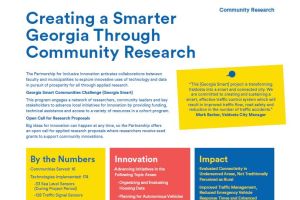 |
|
Robotics has been considered as one of the five key technology areas for defense against attacks with weapons of mass destruction (WMD). However, due to the mass impact nature of WMD, failures of counter-WMD (C-WMD) missions can have catastrophic consequences. To ensure robots' success in carrying out C-WMD missions, we have developed a novel verification framework in providing performance guarantees for behavior-based and probabilistic robot algorithms in complex real-world environments. We cannot assume the luxury of a do-over; we must get it right the first time. 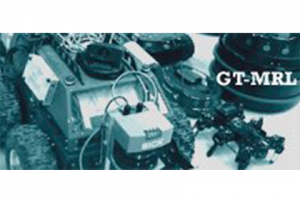 |
Giants in the sky is a Tangible User Interface (TUI) that explores the role of mass and gravity in the life and death of exosolar systems. With the use of various tangibles with different physical attributes, this TUI aims to teach basic concepts of astronomy in science museums. These tangibles allow users to create and manipulate digital celestial objects in a sandbox simulation. 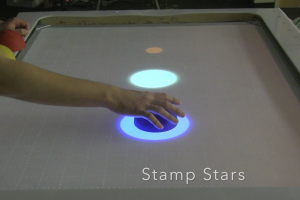 |
Researching how women in Delhi deal with menstrual health outside of their home with the goal of designing an application to aid them in categorizing and finding bathrooms and other safe spaces to meet their needs. |
Graph-Level Operations (GLOs) are a holistic vocabulary of encapsulated manipulations of graph visualization elements. GLOs allow analysts to explore their network data in new and interesting ways, freeing them from being restricted to predefined graph visualization techniques. GLOs also provide software engineers with an alternative, extensible means of writing extensible graph visualization applications. Finally, GLOs provide an elegant method for generating animated transitions between graph visualization techniques. |
|
The gloHood is a wearable technology garment that amplifies and augments the expressive movement of a dancer. It provides the novice audience with an available affordance to better appreciate and understand modern dance, and the dancers new tools to better communicate with the audience, with each other, and with themselves. The garment provides the dancer with a gesture control interface through embedded RFID tags, and a motion control interface through accelerometers sewn into the garment. 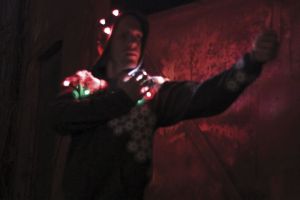 |
The gloSkirt is a wearable technology garment design for Mary Jane Pennington of dance troupe gloATL. The team wanted to give her an experimental tool to challenger her own movement style and better engage audiences new to dance. A base layer of LEDs responds to resistive sensors embedded within layer of the skirt, causing the garment to "pulse" and "breathe" as the dancer crushes and separates with her movements. 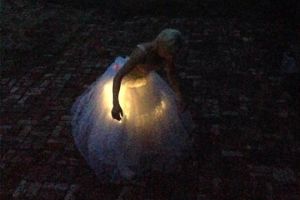 |
The purpose of this study is to evaluate the design of a system to help people manage email overload. The system visualizes data of addresses sending emails to the user’s Gmail account, and allows the user to block or filter messages from listed addresses based on understanding past interactions with messages sent by these addresses. We hope to improve the system, and potentially make it publicly available for improving people’s efficiency in managing their Gmail inboxes. |


